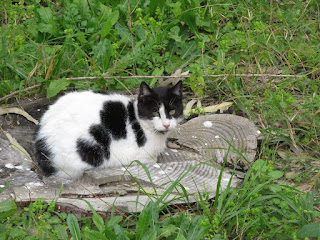I like dogs after a fashion, but I like to be sure that a dog is friendly before I let it get too close to me. One guidebook had a map of Anafi Chora showing "Baskerville Alley". On my explorations I tried to find the dead-end alley shown on the map, but at the same time did not want to find myself cornered in an alley by a savage hound. Dogs patrolled up and down the footpath. They all seemed harmless enough, and sometimes curious.
There were few cats. In Greece, you get used to cats begging at tavernas. Anafi has canine cats. A white dog with ginger spots seemed to have adopted me. "My" dog sat by my taverna table, stared at me with large reproachful eyes, then gave up and wandered away when I did not throw him any titbits. Taverna etiquette on this score varies. I would never throw food on the floor when I was eating indoors. I used to throw the odd titbit on the floor when eating at an outside table. Once, however the owner of a taverna saw me doing this and was most annoyed. She gestured that the cats were dirty and made a noise at night. Since this ticking off I have been more circumspect in what I throw on the floor, and usually go with the scraps of food to the harbour’s edge or a nearby lamp-post or similar. Some places are more easy-going about food for animals; at another place I eat at regularly the owner throws food on the floor for the cats as a tourist attraction. Back on Anafi, there were occasional dog squabbles in street. An elder would tap a walking stick (on the ground, not at the dog) and the dogs dispersed.
The first cat I saw in Anafi was halfway up a telegraph pole. The culprit who chased him there was a brown dog. When his master approached the dog slunk to the ground, his master tapped the dog on the shoulder - and the ginger cat jumped down.
Next morning I was woken at about five o'clock by the sound of a dog barking. A normal bark followed by a long drawn out "wo-ooooooooooooooooo", a really drawn out "ooo" sound. Yet a gentle, long drawn out sound, not a howl, not a grating sound. That must be Baskerville. That was the only morning I was woken by Baskerville, perhaps my subconscious ignored him on future mornings in Anafi. I heard his distinctive bark on other occasions but never managed to see the mutt whilst he produced the bark (and I would not want to unless Baskerville was tied up). I wondered if Baskerville belonged to a fisherman or farmer. No doubt going with his minder to work on terrace or to catch fish. I once saw a sturdy flat fronted brown and white dog down in the harbour (looking as if butter would not melt in his mouth) that I suspected might have been Baskerville.
Anafi Chora is a maze. A small hill towers above the Chora. I wanted to go up there to watch the sun setting over Santorini. I found my way through the tangle of paths and, after a few false turns, climbed up to the hilltop. I went close to Baskerville Alley but neither saw nor heard the hound. After sunset I walked down and found a number of island women sitting on a wall lower down the hill. They had been watching the sunset too.
[late 1990s]



































































